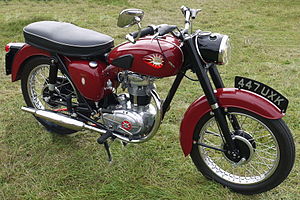BSA C15
 |
|
| Manufacturer | BSA Motorcycles Ltd., Armoury Road, Small Heath, Birmingham, England |
|---|---|
| Also called | Star |
| Parent company | Birmingham Small Arms Company |
| Production | 1958–1967 |
| Predecessor | BSA C12 |
| Successor | BSA B25 Starfire, BSA C25 Barracuda |
| Engine | 4-stroke 249 cc (15.2 cu in) OHV single cylinder, alloy head, Amal 375 carburettor |
| Bore / stroke | 67 x 70 mm |
| Power | 15 bhp (11 kW) @7000rpm |
| Ignition type | Coil with 60 watt Lucas RM13 alternator |
| Transmission | Four-speed, chain drive |
| Brakes | 6 inches (15 cm) front and rear with full width hubs |
| Tyres | 3.25 x 17" front and rear |
| Wheelbase | 51.25 inches (130.2 cm) |
| Fuel capacity | 3 gallons |
The BSA C15 was a 250 cc single-cylinder ohv motorcycle manufactured by the British company BSA from September 1958 until 1967, and was BSA's first four-stroke unit-construction bike. For most of that period, after the introduction of 'Learner Laws' in 1961, a 250 cc was the largest capacity solo machine that a learner could ride unaccompanied when displaying L-plates in the United Kingdom. A road-going Sports derivative was added in 1961, and off-road versions, for Trials and , were also available in the range.
Producing only 15 bhp (11 kW), the C15's lack of power meant that it was hard for the BSA to compete with the more sophisticated Japanese motorcycles (such as the Honda C71 and CB72) which began arriving in the UK in the 1960s.
BSA acquired the Triumph marque in 1951, and the BSA C15 250 cc four stroke was derived from the 200 cc Triumph Tiger Cub, itself coming from the 150cc Terrier. Edward Turner became head of the BSA automotive division and in 1958 BSA introduced the concept of unit construction, where the engine and gearbox were combined in one piece rather than as separate components. The BSA C15 'Star' was the first unit construction model and proved more reliable and economical than its predecessor, the pre-unit BSA C11.
The C11 engine had an iron barrel and alloy head with overhead valves operated by pushrods which ran in a separate tube to fully enclosed rockers. The camshaft was geared directly from the crankshaft with skew gears driving the oil pump and the contact breaker assembly mounted behind the cylinder via a shaft. The alternator was to the left and the primary drive was via a duplex chain to a multi plate clutch. The four speed gearbox was at the rear of the vertically split crankcase. The frame was single loop with twin rails under the engine and pivoted fork rear suspension, and both wheels were 17 inch with full width cast iron hubs. An oil tank was under the seat on the right matched by a toolbox on the left. Between them was an ignition switch panel hiding the battery. The headlamp was fitted in a nacelle which also housed the instruments and switches as was fashionable at the time. Deeply valanced mudguards were fitted to the standard model, making it look heavier than it actually was.
...
Wikipedia
